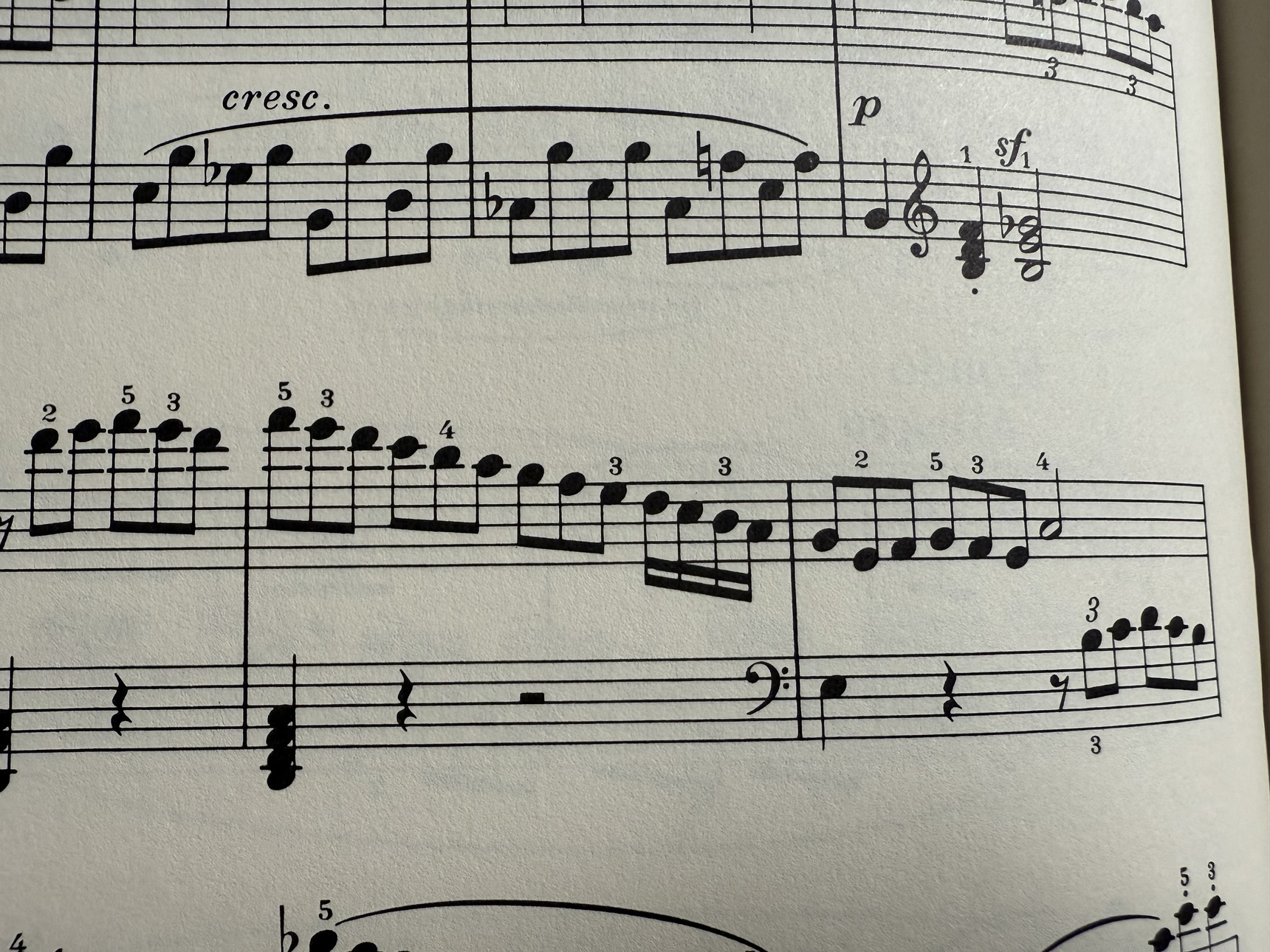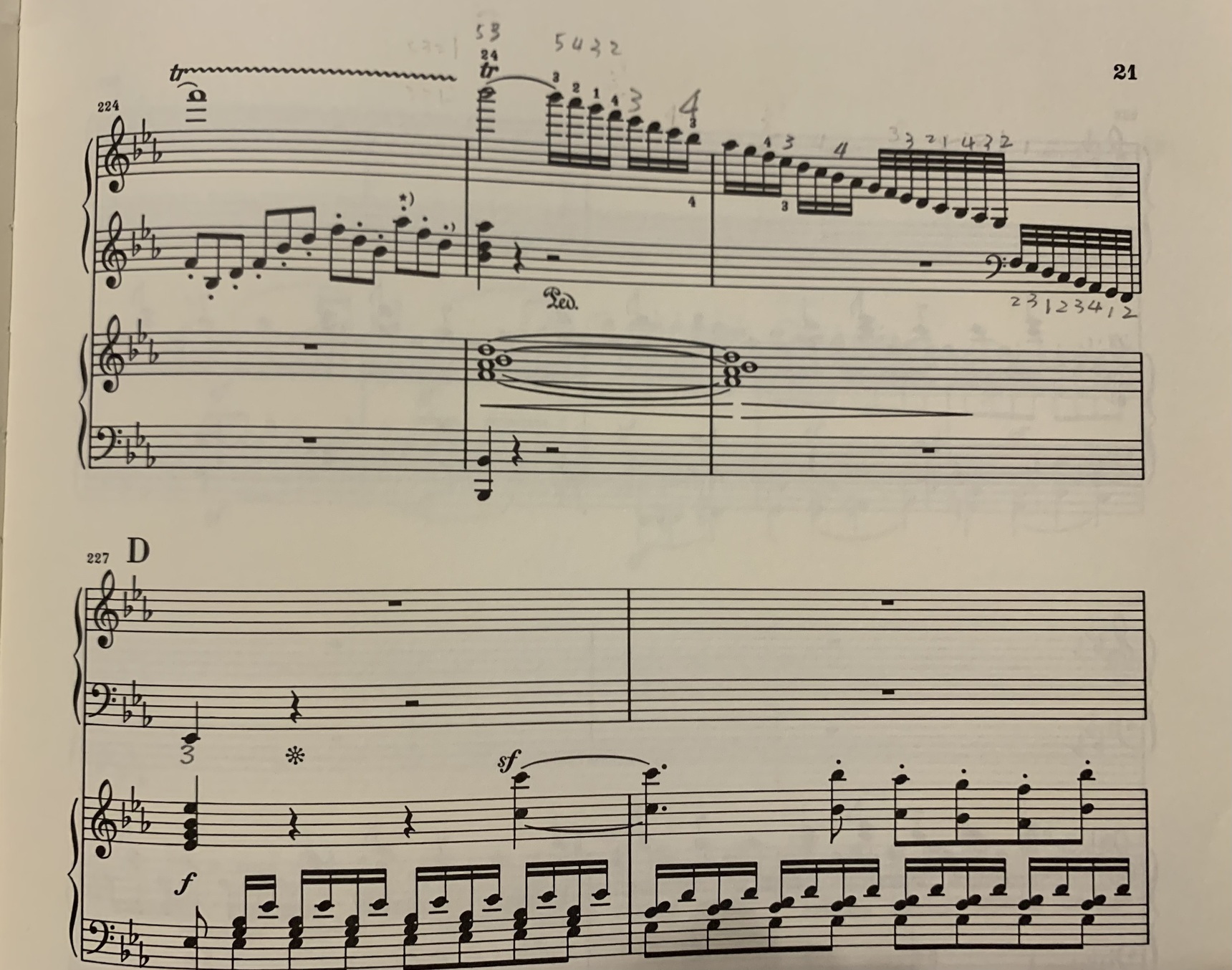Week 1 - Scales, arpeggios, chords and trills!
This week, we’re diving into four essential areas of piano technique: scales, arpeggios, chords, and trills.
In the video, Piotr will guide you through each of these, sharing tips on how to approach them with ease and musicality. We'll also look at specific examples from the repertoire to ground the technique in real music.
Your task: For each element, find at least one example from a piece you know, have played in the past, or are curious to learn. The goal is to apply the technical concepts to music that already feels familiar or accessible.
Write down below any questions, or submit your video excerpts so that Piotr and help you further!
Here are the examples Piotr will show in the video:
Scales: Beethoven Sonata in E major, Op. 14 No. 1, mm. 91–93 (left hand running scales)
Arpeggios: Mozart Piano Quartet No. 1 in G minor, 3rd movement, mm. 67-69 (shaping and transitions between hands)
Chords: Chopin Fantasy in F minor, middle section (voicing, shaping the outer lines)
Trills: Scarlatti Sonata in D minor K. 9 (light, elegant trills that fit the character of the phrase)
After watching the video, spend time exploring where similar techniques show up in your own repertoire. Practice them with the ideas we covered, and focus on sound, ease, and expression.
Let this week be about connecting technique with real music.
Have fun and let me know what you discover!
https://www.youtube.com/watch?v=XHVRVs4OTcA
94 replies
-
Hi everyone! Welcome to TWI :)
I’m looking forward to seeing what kinds of examples you can find. Share some excerpts from pieces you’ve played before or are working on now, old or new. Let’s make these two weeks a great mix of focused work and fun!
-
Excited to take part! Just now watching the first video!
-
What a fantastic idea! Thank you for this video and I practice just I’ll come back home…but my thumb is very crazy…doesen’t want to relax properly and gets in my way in the scales….😫😫
-
THIS! I feel like I should fire my teacher. Demanding “don’t call me til you have all the scales in your hands”. Granted, it’s taken a while. But has he once shown me anything but rote fingerings???
-
Thanks so much for your presentation Piotr. Such a great idea! For the scale element I’ll try and apply it to Chopin Prelude 24😵💫
-
Awesome instruction, Piotr. Thank you. I love this "intensive" approach.
-
Thanks for this. I've made notes for tomorrow's practice. I suspect I'll find plenty of arpeggios, scales & trills in my Bach Little Preludes, whilst I'll probably use the Chopin Preludes I'm studying for chords. Or should I add another composer into the mix - perhaps Mozart for the trill?
-
I have been working on Beethoven's Sonata in C Minor Op. 14 (Pathetique). I feel like I can apply many of the elements of your instruction to this piece. The opening (Grave) of the first movement is great for working on chords as is the reprise of the Grave at measure 135, as well as the Grave section at the end starting at bar 297. There are also 3 passages with trills in the first movement (starting at measure 51 and with its reprise at measure 223, as well as the passage from bars 175-188). The adagio movement has some nice chord passages throughout. The Rondo movement provides some nice arpeggios in the theme. This movement also has many scale passages (i.e. mm 12-16, mm 36-37, mm 59-60, mm 72-76, mm 97-105, mm 116-118, mm 197-201 and mm 207-209).
-
Hi everyone! I worked on the C natural minor scale today and a passage from Beethoven's Pathetique Sonata Op 13 Mvt 3. I am also on Day 5 of recording my own practice for 30 minutes. Applying Piotr's method went pretty well. I think I can rewatch the video again to better apply the methods.
One question: I noticed that the fingering for Beethoven's Pathétique (Schirmer's edition) is completely different from Hannon's scale because Beethoven starts and ends at different places. Is there a point in practicing the scale and the passage together in this case?
-
Hello Piotr, thank you for offering this intensive. Here are some pieces I am working on that could benefit greatly from your teachings:
ARPEGGIOS:
Bach Prelude in G from Book 1 of Well Tempered Clavier. I call this piece Bach's gift to those who have been dutifully practicing their arpeggios. It's a little showpiece featuring arpeggios as a key component, and where the standard textbook fingerings for each inversion seem to work best. I'm trying to push the tempo to be as fast as my technique will allow, but in the process I tighten way up and lose control of the volume and togetherness of the hands. I DO find that lifting my hand for each new chord inversion helps me keep the hands together, & so I'm interested in hearing what you have to say about that, since you are advocating in general not to lift the wrist too much. Here's a video of me playing it at a medium tempo.
------------------------------------
SCALES:
the G major Fugue from Book 1 offers several scale runs from 1-1.5 octaves each. I find again that the textbook standard fingering works best for all of them but 1. Here's a video of me playing it at about 1/8th = 148 MM, , with a guide below that of where the scales appear. I'd like to bring the tempo up to about 160 MM, which appears to be within reach for me, but, so far, I'm slowing down too much in the hard parts . Anyway, here it is at 148:
-------------
Scale passages:
m.23: 0:59 D Major in LH
m.27: 1:08 G major in LH
m.34: 1:24 G major in RH
m.35: 1:27 C major in LH
M.36: 1:29 A melodic minor in LH
m.37: 1:31 E minor in RH *"standard fingering does not work here
m.73: 2:58 G Major in LH
m.74: 3:00 C Major in RH
m.75: 3:03 A minor in RH
m.76: 3:06 D Major in LH
--------------
CHORDS:
Rachmaninoff Prelude in A Major, mm. 15 - 25 and mm.37-40
At mm. 15-25, There is a long melodic line in 9/8, which is played in octaves with chords, in the rhythm of 9/8 triplets.
Dominic provided some great advice on this section in one of his "tricky passage" sessions, on fingering this section and dealing with some of the stretches required by the score.
I've attached a PDF below of the page for this section.
At mm.37-40, the falling-6th theme is stated using different inversions of the A Major Chord.
Here is a very rough practice take of this piece.
the sections in question appear at 0:56-1:25, and at 2:08-2:20
-------------------------
TRILLS:
The above G major Fugue offers a difficult 3-5 or 4-5 trill at measures 69-70.
I'm also working on (and having trouble with) the LH trills in the B Major Prelude from Book 2 of the WTC. I got some great advice on these from Leann Osterkamp's work shop and also from Dominic in one of his "Bach is difficult!" sessions, but still haven't mastered them:
thank you!
-
Hi everyone, I am working on Beethoven’s piano concerto No. 3 first movement. This is the first piano concerto that I have ever practiced. It has all the technique elements discussed in this lesson. There are a few Beethoven’s signature scales, for example, in mm 225-227. There are also parallel scales at the octave or at other intervals that I found quite challenging. The cadenza has the most amazing arpeggios and chord progressions. The double and triple trills at the end of the cadenza are difficult to figure out. I hope to have some guidance as to how to approach these measures. I am attaching pictures of the problematic sections. Thank you, Piotr



